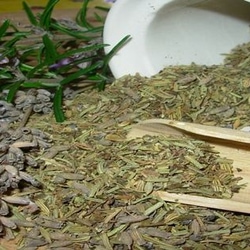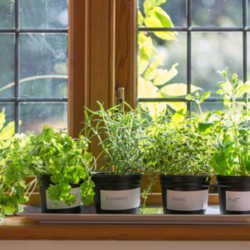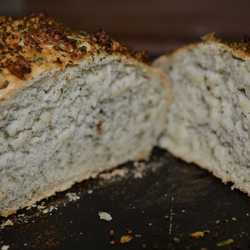Do you want to try to grow herbs for the first time? Basil, chives, and parsley are familiar to many home gardeners and cooks, and also among the easiest herb plants to grow.
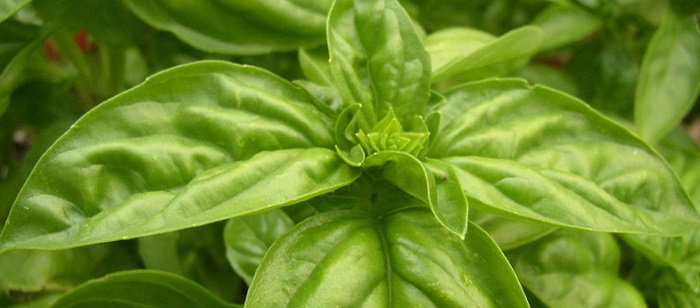
Basil
Basil is an annual herb plant. "Sweet basil" is the most common variety offered, though there are many other decorative and tasty basil cultivars. Common sweet basil grows large, tender, savory leaves and is a fine choice for a first herb garden. It will grow quickly in warm weather, to a bushy plant with several stems a foot or more tall. Cut individual basil leaves at any time that you think the plant can spare them. The flavor of basil perfectly complements summer-ripe tomatoes. Basil is the classic green for pesto, and delicious in a simple chicken cacciatore sauce.*
Chives
Common chives look like tiny scallions growing close together in a group. They have dark green tubular leaves like miniature straws. (Garlic chives are not for casual beginners; read this article to see why.) Chive plants look like a clump of grass eight to ten inches tall. Chive foliage can be cut all summer, allowing new leaves to grow from the base of the plant. Chives are the classic baked potato sprinkle, and take scrambled eggs from simple to special. Chives' mild onion taste can enhance any savory recipe.
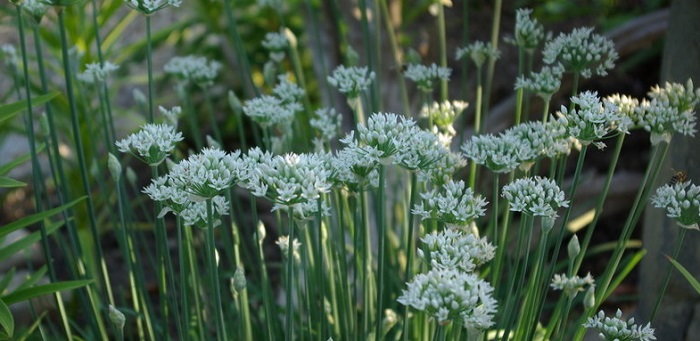
Parsley
Parsley is a cousin to carrots. Flat leaf parsley has an intense flavorful quality. Curly leaf parsley is the type you have probably seen used as decoration on a restaurant meal. The two kinds are interchangeable in growing and using. Parsley grows well in sun but can tolerate some shade. Minced fresh parsley adds green color and a classic, fresh taste to all salads and soup recipes.
Basil, chives and parsley are all commonly sold as young plants. These starters are either ready to plant in a large pot or any free spot in your garden.
For a large mixed container planting: A fourteen inch, standard deep pot can easily hold five or six starter plants. Mix and match as you like. (Note: if you like a lot of basil, that fourteen inch pot will probably support three or four plants, not five or six.) The basil will get large and tall, the parsley leaves will grow out low, and the chives have a grass-like, spiky style. Use a good quality potting mix. "Moisture control" mixes are great for containers. Add a slow release fertilizer to the potting mix as you plant, or add gentle soluble fertilizer to the regular waterings of the filled pot. Set the herb pot where it can get six or more hours of full sun each day. Water it regularly to keep the plants growing so you can cut lots of herb leaves. The family chief cook will appreciate an herb pot convenient to the kitchen.
For the garden: Basil, chives, and parsley all enjoy six hours or more of sun and reasonably fertile soil. Parsley can do well with some shade, too. Set aside a dedicated space in the vegetable garden for herbs, or tuck each plant in where it may fit. Some gardeners use herbs as companion plants. Sweet basil is thought to repel aphids, mosquitoes, mites, and tomato hornworms. Herbs can also be pretty in the flower border. Parsley fits in as an edge plant, while basil becomes tall and could be placed behind shorter flowers. Chives may produce flower stems, each topped with a pretty purple ball shaped bloom. Water all of these herbs regularly so they continue to make new tasty tender leaves to harvest.
Using basil, parsley, and chives
You may begin cutting leaves from these herbs as soon as you plant them. Start with a few, but use more leaves as you wish when you see the plants grow. Cut leaves from basil, or cut stem tips to make the plant branch out or to prevent flowering. Cut chives by snipping off leaves near the soil; removing any hard flower stems. Cut parsley leaves near the base of the plant, cutting the larger older leaves first. Though fresh herbs are full of flavor, you must use a larger volume of them than of dried herbs. In general, triple the amount when using fresh herbs in place of dried.
Later in summer, into fall, and next spring
These three herbs, handily, can teach you about annual, perennial, and biennial plant growth. Basil (annual) matures quickly. Cut flower buds as they appear to prolong your harvest. Frost will kill basil. Chives are perennial and should last the season. They will return next year from roots. Parsley is biennial, and cold hardy. It will grow all summer and into fall. As weather warms next spring you will see leafy growth followed by a flower stem. Cut that stem to try and extend the life of parsley, but also buy a new starter plant to be its successor. You'll be at the nursery to buy to buy new basil next year anyway!
~~~~
*My Cacciatore
Adapted from Cook's Illustrated magazine and The Joy of Cooking
Use a few pounds of bone in, skin-on chicken parts. Brown the skin side well with olive oil in a large deep skillet. Then remove pieces to a platter, peel and discard the skin. Meanwhile, add a quarter to half an onion diced, or similar amount of shallots, to the pan to begin cooking, and 4 to 8 ounces sliced fresh mushrooms. Return the chicken to the pan. Pour a large can of crushed tomatoes over all. Add a bay leaf or two, and fresh or dried basil, (I'm sure some minced fresh parsley and chives wouldn't hurt,) good shakes of salt and pepper, and let simmer for an hour or so. You may wish to bone and slightly cut up the chicken before serving, and you may adjust the thickness of the sauce by adding tomato paste (thicker) or diced tomatoes (thinner, chunkier.) Hope you enjoy- it always seems to turn out tasty!
Images courtesy of PlantFiles


